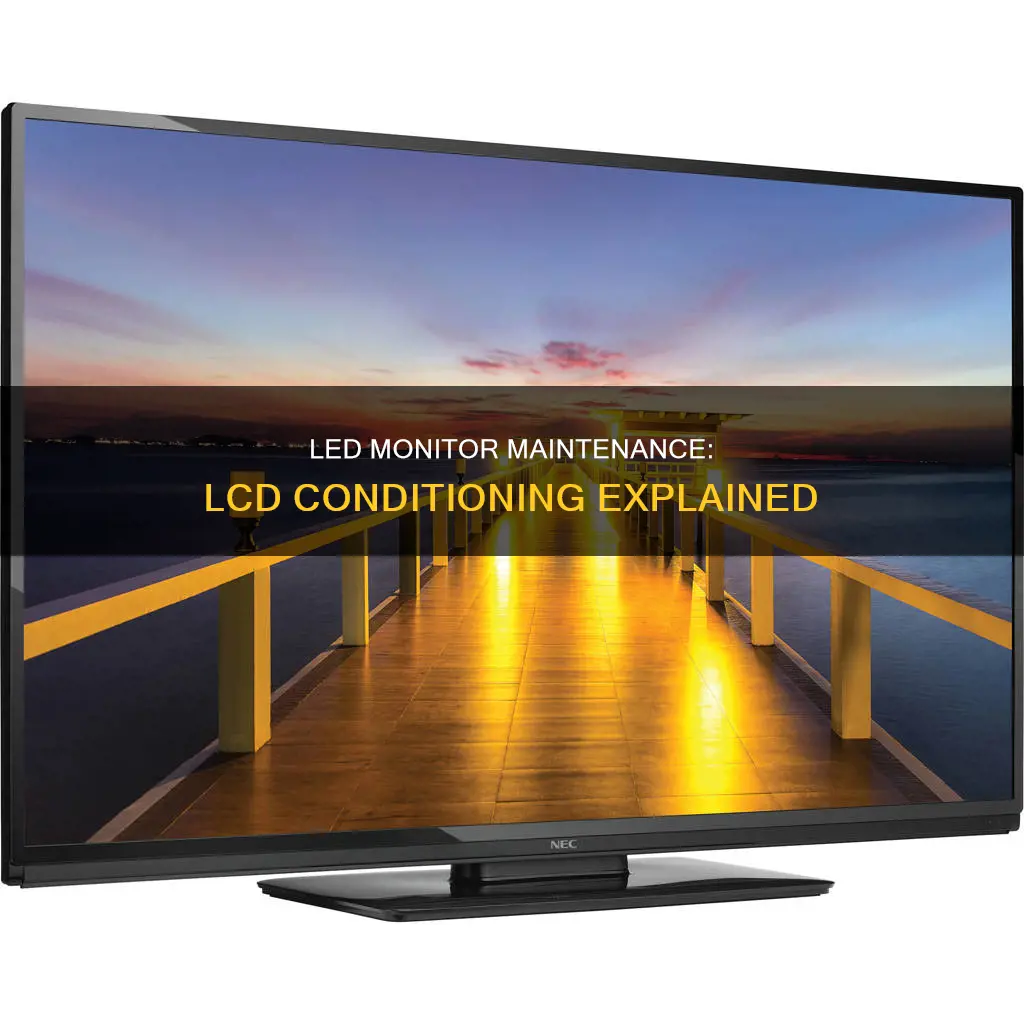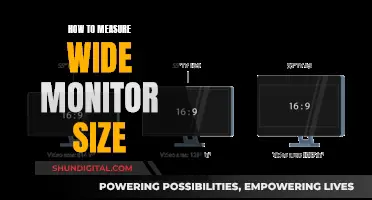
LCD (Liquid Crystal Display) and LED (Light Emitting Diode) monitors differ in their backlighting technology. While all LED monitors are a type of LCD monitor, not all LCD monitors use LED backlighting. Modern LCD monitors are lit with LEDs, which makes them thinner, lighter, and more energy-efficient than their CCFL-backlit predecessors. LED monitors also have a longer lifespan, better colour accuracy, and improved visual clarity. However, LCD monitors are usually more affordable and have more uniform backlighting.
LCD conditioning is a feature that was introduced to reverse image persistence and reduce minor cases of image retention in LCD monitors. It does this by forcing the monitor to display a range of colours or leaving a white image on the screen for several hours. This feature is common in Dell monitors and can be enabled directly from the monitor's settings.
| Characteristics | Values |
|---|---|
| Purpose of LCD Conditioning | To restore full functionality of the monitor and remove image persistence problems |
| How LCD Conditioning works | By cycling the monitor through a series of full-screen colours or lighting all pixels in white for several hours |
| How long does LCD Conditioning take? | There is no set time; it depends on the degree of image retention and is up to the user to decide when to stop the process |
| Downsides of LCD Conditioning | None known |
What You'll Learn
- LCD conditioning fixes visual errors, faults, and malfunctions
- It can be done manually by cycling through different colours on the LCD panel
- LCD conditioning can be done without software by using your own images or playing a YouTube video
- It is a common feature in Dell monitors
- LCD conditioning does not shorten the life of a panel

LCD conditioning fixes visual errors, faults, and malfunctions
LCD, or Liquid Crystal Display, screens are now commonplace, replacing the older cathode ray tube screens. LCD screens have many advantages, such as lower power consumption and longer lifespans. However, they do require periodic conditioning to maintain their maximum resolution.
LCD screens contain a liquid held between two pieces of polarised glass. This liquid reacts to an electric current, which aligns the crystals in the liquid to either allow or block light, depending on the desired colour. This property, combined with a lighting element behind the screen, makes LCDs ideal for computer monitors.
However, a common issue with LCD screens is that they can become "stuck" if the same area is illuminated for extended periods. This occurs when a specific area, such as toolbars, retains its transparency characteristics even after the electricity is removed. This can lead to visual errors, faults, and malfunctions, detracting from the overall viewing experience.
This is where LCD conditioning comes in. LCD conditioning is a process of running a program to rejuvenate the LCD screen and fix any visual issues. These programs are often built into computers with LCD screens, and if not, they can be easily downloaded for free online. It is recommended to run these programs twice a year to maintain optimal screen performance.
The LCD conditioning program works to clear any visual errors, faults, or malfunctions on the monitor. It is a manual checking feature, allowing users to interrupt the process once they are satisfied with the image quality. There is no set time for the program to finish, as it depends on the degree of image retention and is entirely user-guided.
If, after conditioning, there are still issues such as dead or stuck pixels, a physical repair or hardware replacement may be necessary.
Monitoring TV Usage: Track and Control Your Viewing
You may want to see also

It can be done manually by cycling through different colours on the LCD panel
LCD, or Liquid Crystal Display, is a monitor type that features a layer of liquid held between two pieces of polarised glass. The LCD monitor does not produce its own light, instead relying on an electric current to align the crystals in the liquid layer, allowing or blocking light depending on the colour it needs to display.
LCD conditioning is the process of cycling different colours on an LCD panel to remove any visual artefacts or image persistence problems. This can be done manually by cycling through different colours on the LCD panel. This can be achieved by creating your own images and cycling them manually on the display, or by playing one of the many LCD conditioning videos available on YouTube. There is no set time for how long this process should take, and it should only be stopped when you are satisfied with the results.
LCD conditioning is a manual process, and it is up to the user to determine when the image retention has lessened to their satisfaction. It is worth noting that this process can take a while, depending on the severity of the image retention or artefact problem.
While LCD conditioning can be done manually, some monitors may have in-built LCD conditioning features, and some may require external software. For Dell monitors, this feature is known as the LCD Conditioning Program, and it is a feature to clear any visual errors, faults, or malfunctions in the monitor.
GamePlus on ASUS Monitors: What You Need to Know
You may want to see also

LCD conditioning can be done without software by using your own images or playing a YouTube video
LCD, or liquid-crystal display, is a monitor technology that uses a layer of liquid held between two pieces of polarised glass. While LCD screens can produce colour-accurate images, they are not perfect and sometimes require calibration to reach optimal performance. This is where LCD conditioning comes in.
LCD conditioning is the process of cycling different colours on an LCD panel to address any visual artefacts, such as image persistence or stuck pixels, that may appear on the screen. It helps restore the full functionality of your monitor and can be done in two ways: by cycling your monitor through a series of full-screen colours or by lighting all pixels in white for several hours.
Some monitors have built-in LCD conditioning features, while others may require external software. However, LCD conditioning can also be done without software by using your own images or playing a YouTube video. To do this manually, you can create your own images and cycle them on the display or play one of the many LCD conditioning videos available on YouTube.
It's important to note that there is no set time for how long LCD conditioning should be done. It is a manual process that should be stopped when you are satisfied with the viewing image quality. The conditioning time will depend on the severity of the image retention or artefact problem, with more severe issues requiring longer conditioning times.
Updating Your ASUS Monitor: A Simple Firmware Upgrade Guide
You may want to see also

It is a common feature in Dell monitors
LCD conditioning is a feature of Dell monitors that helps clear any visual errors, faults, or malfunctions. It is a common feature in Dell monitors, and it can be accessed through the Menu OSD. The LCD Conditioning program cycles different colours on the LCD panel to remove any visual artefacts and restore the full functionality of the monitor. This process can also be done manually by creating your own images and cycling them on the display or by playing LCD conditioning videos available on YouTube.
The LCD Conditioning program does not have a set time to complete. It is a manual process that runs until the user is satisfied with the viewing image quality and decides to interrupt it. The time it takes to run the program depends on the degree of image retention and the number of artefacts on the screen. If there are more artefacts, the conditioning process will take longer to clear them out.
It is important to note that LCD conditioning is not known to shorten the life of the monitor. It is a safe process that exercises the pixels by displaying full-coloured screens, reducing minor cases of image retention. However, if there are still disturbances in the visuals or dead-stuck pixels after running the LCD Conditioning program, a physical repair due to a hardware fault may be necessary.
Overall, LCD conditioning is a useful feature for Dell monitor users to maintain the quality of their display and ensure a satisfying viewing experience. By running the program or manually conditioning the monitor, users can address any visual artefacts or image retention issues and restore their monitor's performance.
LED vs LCD: Which Monitor is Superior?
You may want to see also

LCD conditioning does not shorten the life of a panel
LCD, or liquid crystal display, screens are an improvement on the cathode ray tube screens they replaced. They use less power and do not burn out as fast, but they do need periodic conditioning to maintain maximum resolution.
LCD screens contain a liquid that reacts to electricity. A small electrical charge applied to a liquid crystal changes its transparency in a small local area. This property, plus a lighting element behind the screen, makes an excellent computer screen.
However, if the same area is illuminated the same way for hours, it can become "stuck". The area in question retains its transparency characteristics when the electricity is removed. These areas are usually on toolbars or other areas that remain fixed for hours while the computer is being used.
LCD conditioning is a feature that can be used to reverse most image persistence or reduce minor cases of image retention. It works by forcing the monitor to display a range of colours or leaving an all-white image on the screen.
There is no set period of time for how long LCD conditioning needs to be run for. It is a process that can be run manually and stopped when the user is satisfied with the results. The conditioning time depends on how severe the image retention or artefact problem is, as more artefacts will require more conditioning time to clear out.
ViewSonic, ASUS, or AOC: Which Monitor Brand to Choose?
You may want to see also
Frequently asked questions
LCD conditioning is a feature that cycles different colours on an LCD panel to remove any visual artefacts and restore the full functionality of your monitor.
There are two methods of LCD conditioning. The first method involves cycling the monitor through a series of full-screen colours. The second method involves lighting all pixels in white for several hours.
There is no set time for how long LCD conditioning takes. It depends on the degree of image retention and the number of artefacts on the screen.
No, some monitors have built-in LCD conditioning features, while others require external software or manual conditioning.
No, LCD conditioning is not bad for your monitor. It is a safe process that simply exercises the pixels by displaying full-coloured screens.







